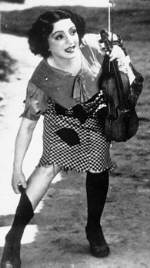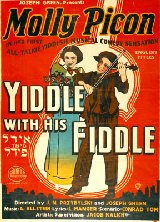 |
Vol 0, No 21
15 February 1999 |
|
|
 K I N O E Y E:
K I N O E Y E:Fiddling in the Face of Adversity The 2nd Brighton Jewish Film Festival, Part I Joseph Green's Yidl mitn Fidl Andrew J Horton As the 1930s rolled on, and fascism went from strength to strength, Jewish identity and culture started to be pushed off the centre stage in Central European life and culture. In response to the terror of this prelude to the Holocaust, Joseph Green made Yidl mitn Fidl (Yiddle with His Fiddle, Poland, 1936), a swingingly upbeat musical which was to become the most successful Yiddish talkie of all time. When a silent Italian film dubbed by Joseph Green into Yiddish met with phenomenal success at a showing in Montreal, the would-be director realised there was a market for a whole new genre of film - Yiddish cinema - made by Jews for Jews and independent of Hollywood and the mainstream American audiences. Green soon also realised that he could cut back on production costs by shooting Yidl mitn Fidl - the first and most popular of the four pre-war films he made - in Poland rather than in America. However, taking on Molly Picon (who later appeared as the matchmaker in Fiddler on the Roof and Frank Sinatra's mother in Come Blow Your Horn) as Yidl was a major expense. He surely did not regret her expense, though: the film was a great success and Green and Picon were to work together again on Mamele (Little Mother, 1938). Drag comedy Yidl mitn Fidl kicks off when, stricken by poverty, Arie and his daughter decide to earn their living as travelling musicians. Since roaming the country is dangerous for a young girl, it is decided that, in true Shakespearean style, she should become a he. And so, Yidl with his fiddle and Arie with his bass set off to seek better fortunes. They soon cross paths with another travelling musical duo. Since joining forces seems more agreeable than competing with each other they form a quartet.
When they arrive in Warsaw, all their idyllic dreams are on the verge of being shattered. The band seem about to split up, leaving Yidl and Arie back where they started, and with all the romances working against the young hero(ine). Can cupid rush in to resolve things at the eleventh hour? Yidl mitn Fidl is a joy on a multitude of levels. The tunes are great, and you'll be humming the title song for days afterwards. Indeed, so popular have the songs been that they have developed a life of their own in Yiddish culture and covers of them are often to be found on compilation tapes of Yiddish music, although, as far as I am aware, there is no collection exclusively devoted to the film. Visually, Yidl mitn Fidl is appealing too, with the action shot in the Kamizmierz shtetl, the countryside around the river Vistula (Wisla), and in Warsaw. This gives the film documentary value, particularly so since Green paid so much attention to recreating everyday Jewish life. Most of the extras were played by ordinary inhabitants of the places in which he filmed, and to recreate the wedding scene Green laid on appropriately wedding-like quantities of food and drink for his "actors" and shot them from dawn until four in the morning, playing out the whole event as if it were for real. Moreover, Yiddish cinema itself is something of a museum piece. The genre never recovered from the war, Jewish culture in Europe died in the gas chambers, and in America increased trends towards assimilation spelt out the end Yiddish cinema. Cinematically aware The film also delights because it is a damned good film. Sylvia Paskin, author of When Joseph Met Molly, explained to the audience at Brighton that on the whole "Yiddish film is interesting cinema but not great cinema." Much of it derives from the Yiddish tradition of theatre and therefore tends to be filmed theatre rather than truly cinematic, giving it value more as a historical record than anything else. Green, however, shows that he genuinely understands the difference between the two mediums; particularly in his use of on-location shooting and his commissioning of original scripts. Recently, audiences have been particularly appreciative of Yidl mitn Fidl, with the film receiving rapturous receptions in America and London, as well as the well-applauded showing in Brighton. So warm was the response at Brighton, festival director Judy Ironside promised the audience that next year Michal Waszynski's The Dybbuk (Poland, 1937) - another successful Yiddish film from the pre-war era - will be shown. Most of all, the film is an endearing show of defiance to Nazism. Green shows never raises his director's voice in complaint or anger, but instead shows the Jewish population enjoying life to the full, unchecked by the rising spectre of fascism. Undoubtedly, the vast majority of the extras in Green's film were to die in the coming years, and yet they refuse to let this dampen their zest for life. Could we, then, accuse Green of naivety? Was he, perhaps, blind to the changes in Europe? Is the film really defiance, or is it the worst sort of escapism? It's hard to say for sure what Green felt when he was making the film. There is one scene, though, which seems to serve exclusively as a pointer to the fact that Green was well aware of the way the tide was flowing. With no other relation to the rest of the plot, Green at one point shows the sky darken and lightning arc menacingly across the sky. A chilling metaphor for what Europe was about to descend into and what even Green's infectious optimism could not halt. Andrew J Horton, 15 February 1999 The Brighton Jewish Film Festival The festival has yet to hit the worldwide web. If you want to find out more about it, I'm afraid you'll have to use more archaic forms of communication: The Brighton Jewish Film Festival Further Surfing If you want to buy Yidl mitn Fidl on video, there are several American outfits which will sell it to you with English subtitles. The film is available from both specialists in Jewish film and in Polish film. However, the cheapest offer I could find was from a company offering German films. If you just want to hear the tunes, then almost any compilation of Yiddish songs will have a cover of one of the film's numbers on it. Try this site here if you want to buy a selection with the film's title song on. If you're not keen on parting with your hard-earned cash until you know what you are getting, then you can read the lyrics in both Yiddish and English and hear a 37-second snippet from a cover version of the title song. (Look in the promotional section.) If it's Molly Picon you're interested in, there's a full site recounting her entire life, including her description of the making of the wedding scene in Yidl mitn Fidl. For a good overview of Yiddish cinema, you could try practising your Finnish by reading Suome Elokuva-Arkisto's article on the subject. |
 The plot is provided by romantic complications between Yidl and Froim. Yidl is helplessly in love but Froim, thinking Yidl is a boy, is less than keen on the attention he is receiving. Things get worse when the quartet rescue a reluctant bride from her wedding, and thus in one swoop enrol both a vocalist and, to complicate Yidl's life still further, an object of Froim's affections.
The plot is provided by romantic complications between Yidl and Froim. Yidl is helplessly in love but Froim, thinking Yidl is a boy, is less than keen on the attention he is receiving. Things get worse when the quartet rescue a reluctant bride from her wedding, and thus in one swoop enrol both a vocalist and, to complicate Yidl's life still further, an object of Froim's affections.